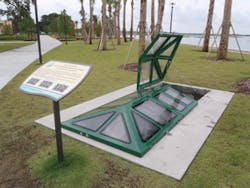The Nutrient Separating Baffle Box: A Key to Trapping Pollutants
A Florida Park Revitalized
Kissimmee Lakefront Park in Kissimmee, FL, desperately needed revitalization. New facilities and buildings were planned and built, and paved surfaces were restored. Another big part of the project was installation of stormwater treatment best management practices (BMPs).
The park covers about 25 acres, situated between the downtown urban area of Kissimmee and East Lake Tohopekaliga. The lake, famous for bass fishing and bird habitat, is a resource that needed to be protected from pollution and trash. The Lake Front Park is heavily visited by local residents and by travelers to nearby Disney World.
A Florida Park Revitalized Kissimmee Lakefront Park in Kissimmee, FL, desperately needed revitalization. New facilities and buildings were planned and built, and paved surfaces were restored. Another big part of the project was installation of stormwater treatment best management practices (BMPs). The park covers about 25 acres, situated between the downtown urban area of Kissimmee and East Lake Tohopekaliga. The lake, famous for bass fishing and bird habitat, is a resource that needed to be protected from pollution and trash. The Lake Front Park is heavily visited by local residents and by travelers to nearby Disney World. [text_ad] A 42-inch pipe passed through the park, draining stormwater from downtown Kissimmee into the lake. For this project, a Suntree Technologies Nutrient Separating Baffle Box was retrofitted into the existing pipe. The SkimBoss Filtration System was also added. The project plan was to use these products to create a treatment train. Two areas make up the treatment zone—first, a hydrodynamic separator for gross pollutant removal, and second, a filtration system to capture dissolved pollutants. The hydrodynamic separator being first in the line means that the filtration media will work more efficiently and last longer without being clogged by large particles. Gross pollutant removal is handled by the Nutrient Separating Baffle Box. The box is designed to fit in line with existing pipe, making it easy to use in a retrofit project. The screen system captures and holds leaves and litter and will keep them contained even during peak flows. The system continues to perform under large flows with minimal head loss, even when the screens are filled with debris. The separation of the organic matter from the water prevents nutrients from leaching into the runoff. The sediment settles to the bottom of the box and is prevented from escaping in future flows. A proprietary turbulence deflector system calms the water and allows even extra-fine particles to settle. The chamber can hold up to thousands of pounds of debris, depending on the size installed. Once the stormwater has flowed through the Nutrient Separating Baffle Box, it passes through the SkimBoss Filtration System. The SkimBoss provides media filtration in line with flows without the usual head loss. The SkimBoss is resistant to clogging because of the fluidized media bed. During dry periods, the media settles to the bottom with about 2 inches of space at the top of the chamber. Once water begins to flow, the media shifts and any clogs are broken up. The hydraulics of the system creates pressure to force the water up through the media bed, providing the filtration. Any solids that remain in the stormwater settle to the space below the media chambers. If heavier flows occur, the SkimBoss rises until the hydraulic pressure on inflow and outflow equalizes. The media continues to filter the flow, and louvers on the media vessel backflush the media. Once the flow decreases, the SkimBoss returns to its normal position. The media used in the Kissimmee Lake Front Park project was Bold and Gold, a media developed by the University of Central Florida (UCF) Stormwater Management Academy. According to Martin Wanielista, professor at the academy, the biggest challenge was to develop media that would have minimum residence time for the removal of nitrogen and a lifetime for the removal of phosphorus. Bold and Gold not only filters the stormwater but also has sorbent surfaces that capture dissolved pollutants. Many other systems trap only pollutants that are attached to sediment. The media is highly effective and fairly inexpensive. It does not have to be replaced often, but can be washed off with a hose and used again. The effective use is up to 20 years. Students from UCF Stormwater Management Academy performed water flow and quality measurements before and after installation at Kissimmee Lake Front Park and monitored samples for total suspended solids (TSS), total nitrogen (TN), and total phosphorus (TP). The results: Average 67% of TN removed Average 79% of TP removed Average 81% of TSS removed An interesting addition to the Kissimmee Lake Front Park project was the addition of a Suntree observation lid. The large clear cover allows the public to look inside and see the system components. The ability to see stormwater treatment in action greatly increases awareness of the importance of clean water practices. The city of Kissimmee won the Florida Stormwater Association’s Outstanding Treatment and Public Education Award for this project in 2014.A 42-inch pipe passed through the park, draining stormwater from downtown Kissimmee into the lake. For this project, a Suntree Technologies Nutrient Separating Baffle Box was retrofitted into the existing pipe. The SkimBoss Filtration System was also added. The project plan was to use these products to create a treatment train.
Two areas make up the treatment zone—first, a hydrodynamic separator for gross pollutant removal, and second, a filtration system to capture dissolved pollutants. The hydrodynamic separator being first in the line means that the filtration media will work more efficiently and last longer without being clogged by large particles.
Gross pollutant removal is handled by the Nutrient Separating Baffle Box. The box is designed to fit in line with existing pipe, making it easy to use in a retrofit project. The screen system captures and holds leaves and litter and will keep them contained even during peak flows. The system continues to perform under large flows with minimal head loss, even when the screens are filled with debris. The separation of the organic matter from the water prevents nutrients from leaching into the runoff.
The sediment settles to the bottom of the box and is prevented from escaping in future flows. A proprietary turbulence deflector system calms the water and allows even extra-fine particles to settle. The chamber can hold up to thousands of pounds of debris, depending on the size installed.
Once the stormwater has flowed through the Nutrient Separating Baffle Box, it passes through the SkimBoss Filtration System. The SkimBoss provides media filtration in line with flows without the usual head loss. The SkimBoss is resistant to clogging because of the fluidized media bed. During dry periods, the media settles to the bottom with about 2 inches of space at the top of the chamber. Once water begins to flow, the media shifts and any clogs are broken up. The hydraulics of the system creates pressure to force the water up through the media bed, providing the filtration. Any solids that remain in the stormwater settle to the space below the media chambers. If heavier flows occur, the SkimBoss rises until the hydraulic pressure on inflow and outflow equalizes. The media continues to filter the flow, and louvers on the media vessel backflush the media. Once the flow decreases, the SkimBoss returns to its normal position.
The media used in the Kissimmee Lake Front Park project was Bold and Gold, a media developed by the University of Central Florida (UCF) Stormwater Management Academy. According to Martin Wanielista, professor at the academy, the biggest challenge was to develop media that would have minimum residence time for the removal of nitrogen and a lifetime for the removal of phosphorus. Bold and Gold not only filters the stormwater but also has sorbent surfaces that capture dissolved pollutants. Many other systems trap only pollutants that are attached to sediment. The media is highly effective and fairly inexpensive. It does not have to be replaced often, but can be washed off with a hose and used again. The effective use is up to 20 years.
Students from UCF Stormwater Management Academy performed water flow and quality measurements before and after installation at Kissimmee Lake Front Park and monitored samples for total suspended solids (TSS), total nitrogen (TN), and total phosphorus (TP). The results:
Average 67% of TN removed
Average 79% of TP removed
Average 81% of TSS removed



